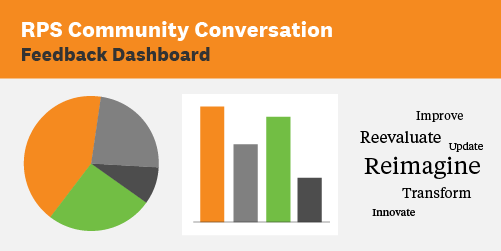Community Engagement Initial Results
The first phase of conversations on Reimagining Public Safety (RPS) between the community and City leaders concluded on January 31, 2021. These conversations were launched in September 2020 to help inform City leaders’ decisions on public safety reform. Community members were invited to submit their feedback through one of a variety of online and call-in input options, including:
- RPS Listening Session for One
- Austin 3-1-1 Reimagining Public Safety Feedback line
- RPS discussion forum on SpeakUp Austin
- RPS short survey on SpeakUp Austin
Additionally, community members and organizations were invited to host virtual, scenario-based community conversations with their members, neighbors, or friends or to participate in a session hosted by City leaders. During these sessions, participants discussed a series of example scenarios, such as people arguing in an upstairs apartment, and submitted their responses to questions on the kinds of public safety resources they would like to have in each type of situation.
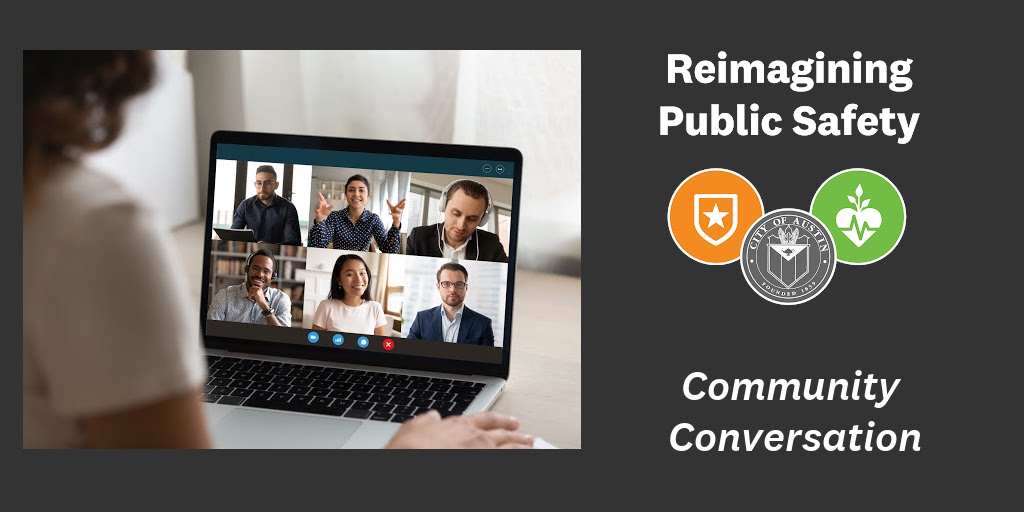
METRICS ON RPS COMMUNITY ENGAGEMENT TO DATE
Nearly 1,000 people participated in an RPS community conversation and/or submitted their feedback through one of the other input options. Participants in the overall process came from a range of districts and zip codes, and they represented a wide range of ages, genders, races, and ethnic groups.
Each of Austin’s ten Council Districts hosted a community conversation, plus there were three citywide sessions (including one fully in Spanish) and dozens of sessions hosted by a diverse range of community organizations and neighborhood associations across the city.
Some of the community partners that participated in these conversations included Austin Justice Coalition, Austin Voices, Caritas, Integral Care, Maternal Health Equity Collaborative, the South Asians’ International Volunteer Association, and YWCA Greater Austin. City communications staff helped facilitate many of these conversations and provided technical and other critical support to help make these sessions a success.
OVERALL THEMES: WHAT WE HAVE HEARD SO FAR
Participants gave a wide range of feedback on how they want public safety resources to show up in their community and how to make public safety work for Austin. This ranged from people who rely on law enforcement officers as the primary guardians of public safety to people who believe that police threaten the safety of individuals and communities across Austin.
For example, in the RPS short survey on SpeakUp Austin, just under half of respondents rated their overall public safety experience in Austin as “Excellent” or “Good,” while over 50% said their experience has been fair, poor, or a mixed experience.
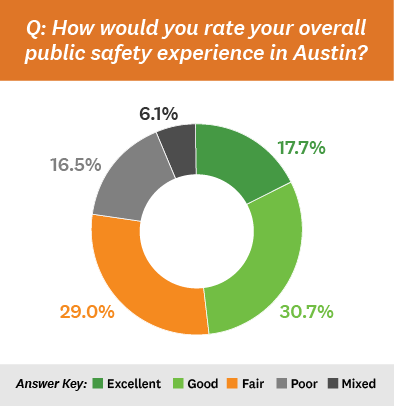
Participants often described how their personal experiences with public safety resources like law enforcement or those of friends and family have shaped their views. Many people acknowledged that how safe people feel in certain situations or the perceived need for police involvement can vary greatly by race, gender, and other personal circumstances, such as identifying as transgender.
Some of the other key themes we heard included:
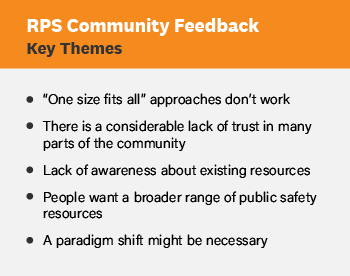
“One size fits all” approaches don’t work - Whether people want law enforcement involved depends on the context of a situation. Participants said they are more likely to want a police officer involved if the situation is violent. However, many people aren’t sure how to determine whether a situation is or will become violent. In general, the people who said they wouldn’t call the police said they are concerned that calling the police might escalate the situation or generally do more harm than good.
There is considerable lack of trust in many parts of the community – of police, of government, of neighbors, and of each other in general.
Lack of awareness about existing resources - The City needs to do more to make the community aware of the public safety resources that are currently available.
People want a broader range of Public Safety Resources - Many participants want additional resources to help deal with situations that impact public safety, including preventative programs, specialized responders, and policies. People also said there’s a need for resources to help all sides of an incident, including victims, perpetrators of crimes, bystanders, and police and other first responders. Some examples of public safety resources that participants would like to have included:
- Increased mental health resources, including accessible and affordable counseling to prevent violent situations, as well as mental health specialists to respond to relevant situations on their own or accompany a police officer
- Equip people to deal with issues on their own at the community level, such as through neighborhood watch groups and by providing resources to neighbors in need
- Greater availability of victim services, such as funds for property crime victims to replace stolen items and temporary housing for people needing to flee violent situations, as well as giving those in domestic violence situations a voice in what they need
- Complimentary roadside assistance throughout the city and in areas other than just highways
- Change the insurance claims process, so people don’t have to call police to get an incident report for theft or car accidents to make an insurance claim
- More youth services, such as affordable afterschool activities and childcare options
- Substance abuse rehab resources since participants expressed that drugs are not a criminal justice problem alone
- Greater support for 3-1-1 or another hotline, so they are better equipped to handle calls alongside 911 dispatchers who could triage calls and send out the most effective/relevant resources for a particular situation
A paradigm shift might be necessary. Some participants said we need major changes in City systems, values, and culture, but others said they think everything is fine as it is. Of participants that expressed a need for significant change, examples of the suggestions they said could help improve public safety included:
- Taking a more proactive approach in order to prevent people from getting into trouble and to deal with issues before they rise to the level of needing police. Some of the underlying circumstances participants mentioned that they would like to see addressed as a way to reduce crime included many economic-related stressors, such as the lack of basic needs like stable housing, food security, reliable transportation, and employment.
- Improving law enforcement training to include more education on de-escalation, implicit bias, and cultural sensitivity
- Dividing police into divisions, where police would not be armed in most divisions, and giving officers specific training for certain kinds of situations, such as domestic violence, traffic stops, burglary, etc.
- Requiring police to regularly undergo counseling to help prevent them from carrying the scars of traumas they experience on the job into their next interaction with community members or even in their own home and personal life
RPS COMMUNITY CONVERSATION FEEDBACK DASHBOARD
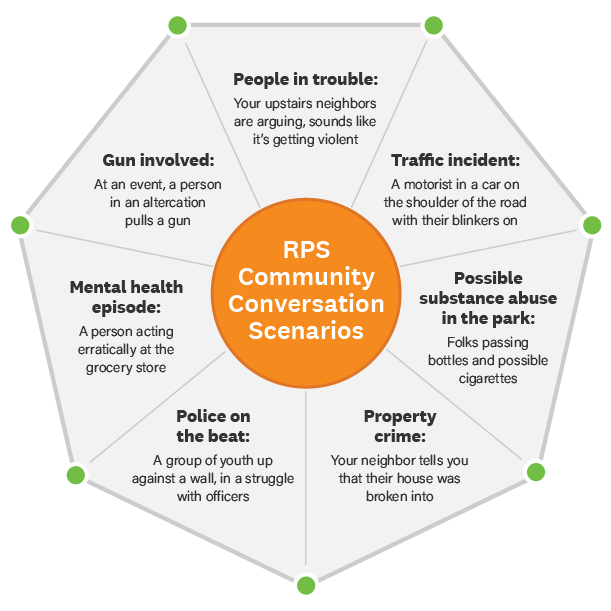
An in-depth "Listening Session" survey tool was at the core of the engagement process. The tool, developed by Innovation Officer Kerry O'Connor and Alba Sereno, the City's Chief Research & Strategic Initiatives Officer, was designed to promote thought and discussion around several scenarios which may involve a law enforcement response.
Each scenario asked several questions including: How would participants respond in a situation, do participants want police involved, what resources are needed to address the issue at the center of the scenario, and how participants might reimagine a response?
More than 30,000 pieces of data were collected from the listening session survey responses. The Innovation Office conducted an analysis of the data to identify key themes and patterns in the responses and developed an interactive RPS feedback dashboard. With this tool, you’ll be able to sift through summaries and analysis of participants’ feedback on each of the example scenarios.
Click Image to view the feedback dashboard.


